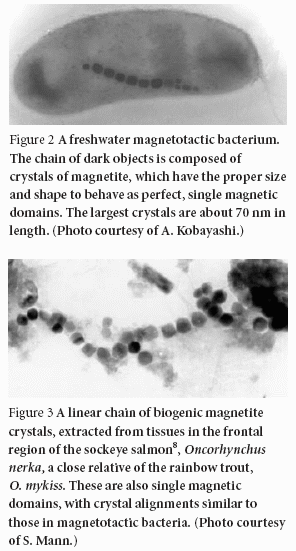
I've been finding lately that if you look deeply into just about any aspect of life it quickly becomes fascinating. Like migration, for instance...
The story starts with something called 'magnetotactic bacteria' - bacteria that have DNA that creates tiny magnetite (Fe[sub]3[/sub]O[sub]4[/sub]) particles that can act as tiny compasses...

From Magnetotactic bacteria
Magnetites from magnetotactic bacteria MV-1 are elongated. The elongation adds to the magnetic pull of these tiny compasses and thus helps the bacteria locate sources of food and energy. This team of authors found that the elongation was accomplished by the addition of six faces, shown in red in the figure [above]. "The process of evolution on Earth has driven magnetotactic bacteria to make perfect little bar magnets, which differ strikingly from anything found outside biology," says coauthor Joe Kirschvink
And it turns out that birds, sea turtles and salmon also have these tiny magnetite crystals... From The Physics and Neurobiology of Magnetoreception:
Evidence for a magnetic map in sea turtles.
Juvenile sea turtles establish feeding sites in coastal areas and home back to these sites if displaced. To investigate how turtles navigate to specific sites, juvenile green turtles were captured in their coastal feeding areas near Melbourne Beach, Florida. Each turtle was tethered to an electronic tracking system and placed in a pool of water. The pool was surrounded by a magnetic coil system that could be used to replicate the magnetic fields that exist at two distant sites. Turtles exposed to a magnetic field that exists ~330 km north of their feeding grounds oriented southward, whereas those tested in a field that exists an equivalent distance to the south swam north. Therefore, turtles responded to each field by swimming in the direction that would have led towards the feeding area had they actually been in the locations at which the magnetic fields exist.
The results indicate that sea turtles have a type of ˜magnetic map' that facilitates navigation to specific geographical areas.
And scientists are starting to figure out how this 'magnetic sense' works...
From Homing in on Vertebrates
Joseph L. Kirschvink, Nature - 1997
...
All known sensory systems have specialized receptor cells designed to respond to the external stimulus, and these are always coupled to neurons to bring this information to the brain.
...
It took nearly two decades to realize that the geomagnetic compass used by adult birds was programmed to be ignored if other orientation cues (such as a Sun or star compass, polarized skylight, infrasound and ultrasound) were present. These orientation cues constitute a complex but consistent web of interacting responses, which are used not only by birds but in all major vertebrate groups and many invertebrates.
There is some (controversial) evidence that the magnetotactic bacteria that started all of this originated on Mars:
From Magnetite-based magnetoreception
Magnetoreception may well have been among the first sensory systems to evolve, as suggested by the presence of magnetosomes and magnetosome chain structures in the 4.0 billion year old carbonate blebs of the Martian meteorite ALH84001. Although this is nearly half a billion years older than the oldest microbial fossils on Earth, it suggests that this genetic ability was brought here from Mars via the process of panspermia. In terms of the evolutionary arguments presented above, the striking similarity in magnetosome structure and organization in bacteria, protists, and vertebrates, and the deep fossil record, supports the hypothesis that magnetite biomineralization system arose initially in the magnetotactic bacteria and was incorporated into eukaryotic cells through endosymbiosis; later, it may even have been used as a template to drive the widespread biomineralization events during the Cambrian explosion.
Comments